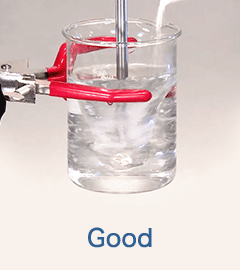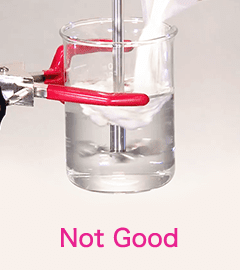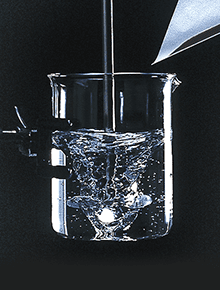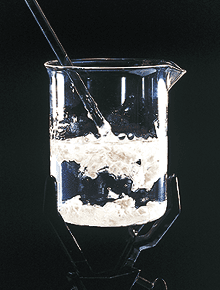Alginate Usage
- Home
- Alginate Usage
How to dissolve Alginate
Alginic acid, Alginate salts, and Alginate derivatives (collectively referred to as “Alginate”) can be used in their powdered form or dissolved in water to create a solution for various applications. In many cases, the amount of alginate used is minimal (typically around 1-2% of the final product), so achieving uniform distribution of alginate throughout the mixture is crucial to fully harness its functionality.
When incorporating as a powder
Simply adding a small quantity of alginate powder directly into the mixture may not result in an even distribution. To ensure uniform mixing, start by setting aside a portion of the main ingredients (approximately 10%) and mix the required amount of alginate powder into it as a primary blend. Then, reintegrate this mixture into the overall mixture to achieve a more even distribution of alginate.
When using as a water solution
Alginate is a water-soluble polymer that, when dissolved in water, forms a viscous colloidal solution. When using alginate as a thickening agent or gelling agent, it is essential to ensure that the alginate is thoroughly dissolved, creating a homogeneous aqueous solution. Alginate is inherently highly hydratable and has good water solubility. However, due to its high hydratability, it can sometimes form lumps or be perceived as ‘difficult to dissolve’ in certain situations.
Solubility of Alginates
Salts of alginic acid with monovalent cations (Na-salt, K-salt, NH4-salt) as well as Propylene Glycol Alginate are all soluble in cold & hot water, and generate viscous aqueous solutions (Table 1).
Alginic acid and calcium alginate are water-insoluble.
All the alginate salts are insoluble to fats & oils and organic solvents.
Table 1: Solubility of alginate in various types of solvent
| Type of Alginate | Solubility | ||
| Cold & Hot water | Fats & Oils | Organic solvents | |
| Alginic Acid | Insoluble | Insoluble | Insoluble |
| Sodium Alginate | Soluble | Insoluble | Insoluble |
| Potassium Alginate | Soluble | Insoluble | Insoluble |
| Calcium Alginate | Insoluble | Insoluble | Insoluble |
| Ammonium Alginate | Soluble | Insoluble | Insoluble |
| Propylene Glycol Alginate | Soluble | Insoluble | Insoluble |
Solubility of alginate can alter with the properties of the solution (pH, concentration of cation, etc.)
Care is required when making a solution of low pH or a solution that contains polyvalent cations, because alginate has a limited solubility in these systems.
Table 2: Solubility of alginate in various types of solution
| Solubility | |||
| In an acidic system | In an alkaline system | In a solution with polyvalent cations | |
| Fruit juice, Sake, Salad dressing, etc. | Lye water, etc. | Hard water, Milk, etc. | |
| Alginic Acid | Insoluble | Soluble | Insoluble |
| Sodium Alginate | Insoluble | Soluble[1] | Insoluble |
| Potassium Alginate | Insoluble | Soluble[1] | Insoluble |
| Calcium Alginate | Insoluble | Insoluble[2] | Insoluble |
| Ammonium Alginate | Insoluble | Soluble[1] | Insoluble |
| Propylene Glycol Alginate | Soluble | Soluble[3] | Soluble |
Dispersion of alginate to produce a homogeneous alginate solution
Alginate product as a dried powder.
We have a variety of products from granules to fine mesh for various applications.
To dissolve alginate in a short time, it is important to disperse alginate into the water uniformly. Alginate powder dispersed in water gradually swells and dissolves.
Alginate which is dispersed uniformly has a large surface area and can be dissolved in a short time. Meanwhile, it takes longer for the lumps to swell and dissolve.


Table 2: Solubility of alginate in various types of solution
(1) Using a high speed stirrer
Add alginate powder to the water gradually with rapid stirring.
(2) Premix with a hydrophilic powder
Before dispersing into water, make a uniform mixture of alginate powder with a hydrophilic powder, such as sugar. Then, add the mixture into water as in 1.
(3) Premix with a hydrophilic liquid
Before dispersing, make a wet mixture of alginate powder with a hydrophilic liquid, such as alcohol and glycerin. Then add the mixture into water with stirring.
Dispersion and dissolution using a high speed stirrer
By rapid stirring
Add alginate gradually into the water while stirring using a high speed propeller-type stirrer.
Keep stirring the solution until all the alginate material is dissolved.
Notice
* This is the standard method to disperse and dissolve alginate into water in a short time.
* For this method, a high speed stirrer is required which has enough power to stir the water inside the tank.
* When alginate is dissolved, the solution becomes viscous. Thus, a stirrer which can stir viscous liquids is required.
* If any powder adheres to the blades, wall of the tank, etc., stop stirring and check.

Poor dispersion with lumps
If the alginate is not dispersed uniformly, the powder surface is only wetted and lumps are generated. It takes a considerable time for the lumps to dissolve homogeneously.
If alginate lumps are left in water for a long time, they will swell and dissolve.

Dispersion and dissolution by premixing
Premix with a hydrophilic powder
Before adding to water, premix with a hydrophilic powder such as sugar and salt. It reduces the time to dissolve and avoids lumps with a slow speed stirrer.
Once dispersed uniformly, a homogeneous solution is easily obtained.
To disperse effectively, the quantity of hydrophilic powder should be 6 times the alginate powder.
With alcohol
Alginate is not soluble in alcohol.
Add a small quantity of alcohol (e.g. ethanol) to the alginate powder and make a slurry. Add water to this slurry immediately, this causes the alginate to disperse without lumps.
Once dispersed, it is possible to make a homogeneous solution even at slow stirring speeds.